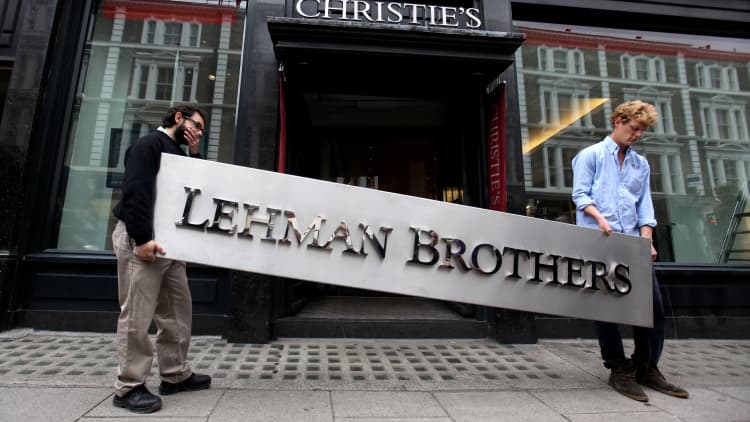
For many investors, the financial crisis of 2008 and the economic shutdown caused by the coronavirus are the only two bear markets they have experienced in their lives. Where are we now compared to 2008? Here is one way to look at that question and try to help understand why, even as the S&P 500 and Dow Jones Industrial Average have surged back with gains equal to a new bull market since the March 23 low, many investors remain skeptical. The S&P and Dow were up double-digits, percentage-wise, this week alone.
About one month ago was a day that some refer to as Black Thursday, after President Donald Trump announced the Europe travel ban, the NBA suspended its season, and Tom Hanks and his wife Rita Wilson became the most famous Americans to say they had contracted COVID-19.
A look back at how stocks performed after the market had about a month to digest the Lehman Brothers bankruptcy in 2008 shows one reason for short-term hesitation to jump back in related to financial crisis experience.
With a start date of Oct. 14, 2008, roughly four trading weeks after Lehman, the S&P 500, its sectors, and the Dow Jones Industrial Average, all performed poorly in the following one-month and three-month periods, according to a CNBC analysis of data from Kensho. The S&P 500 was down more than 14% in these one-month and three months, while the Dow dropped by 11%, according to a CNBC analysis of trading data from Kensho.
Utilities was the top performer, down 4% in the one-month period and the only sector higher over three months, with a 2% gain. Materials, the best performing sector this week, up nearly 20% and on pace for its best week ever, dating back to 1989, were second-worst among S&P sectors, ahead only of financials, in the months after the Lehman bankruptcy.
Stocks just had their best week since 1974, even with Thursday's jobless claims bringing the three-week unemployment toll to 16 million Americans. The recovery since the March low has been the fastest in history. In no previous period, including 2008, did "stocks manage to claw back as much of the losses as quickly as they've done this time," wrote the Sentimental Trader in a post this week.
The Federal Reserve helped again on Thursday, announcing as slew of programs, including loans geared towards small and medium sized businesses, that will total up to $2.3 trillion. The central bank also gave more details on its plans to buy investment-grade and junk bonds.
But signs of a recession are everywhere: One Bloomberg tracker put the odds at 100%. Meanwhile, a measure of decline in electricity usage shows a picture that makes the Great Recession look healthy.
The COVID-19 models have improved in their outlook. Former FDA Commissioner Scott Gottlieb noted on Thursday that the models used by the federal government are showing better signs for the scope and length of the epidemic, as well as far fewer deaths than a worst-case scenario.
There are a variety of professional investors who are buying back in for a variety of reasons: short-sellers squeezed by the sharp reversal and forced to cover positions, funds managers who can't afford to miss out on gains or risk falling far behind the indexes. "This is trader and professional money driving this market," Scott Wren, a managing director at the Wells Fargo Investment Institute, told the New York Times.
While some say mom-and-pop investors are sitting out this comeback, Vanguard Group, the investing giant synonymous with retail investors and financial advisors, took in $47 billion in equity ETF flows in the first quarter, according to Bloomberg, suggesting many were never scared off, even as the market tanked.
Mark Cuban remains cautious and is raising cash. Howard Marks, co-founder of Oaktree Capital, says stocks are cheap and buying opportunities abound, but he still expects another leg down in the market.
S&P 500 sectors in the aftermath of Lehman bankruptcy
| S&P sector | 1-month return | 3-month return |
|---|---|---|
| Consumer staples | -5.98% | -6.48% |
| Consumer discretionary | -19.19% | -10.26 |
| Technology | -14.86% | -12.47 |
| Healthcare | -8.70% | -5% |
| Industrials | -14.78% | -15.42% |
| Utiliities | -4.23% | 2.22% |
| Materials | -21.34% | -19.78% |
| Energy | -11.88% | -7.56% |
| Financials | -27.87% | -43.31% |
Source: Kensho
Single points in market history are not statistically significant indicators of future performance. And there are scant data points to use. For the dot-com bubble bursting, there was no single "inciting" event that makes for an easy comparison point. And after 9/11, the markets were closed for a number of days right after the attack.
There are other reasons to be cautious to read too much into a single crisis trading period. Financials were down more than 40% in the three-month period referenced here related to the Lehman bankruptcy, and for obvious reasons that are not likely to be repeated.
Another important point: The financial crisis and Lehman bankruptcy occurred right near a presidential election, according to Nicholas Colas, co-founder of DataTrek Research, who has been studying the relationship between 2008 and today for trading intelligence.
"There was a U.S. general election on Nov. 4 [2008], which is smack in the middle of this time series. The S&P 500 dropped 5% in each of the next two days after, because it was clear that we had to wait months for fiscal stimulus since D.C. had no mandate. That's really what made the November lows. And why the ultimate low was in March 2009."
While Republicans and Democrats were sparring over another round of stimulus this week, "that's the big difference: D.C. owns the current crisis and has therefore responded much more quickly," Colas said.





